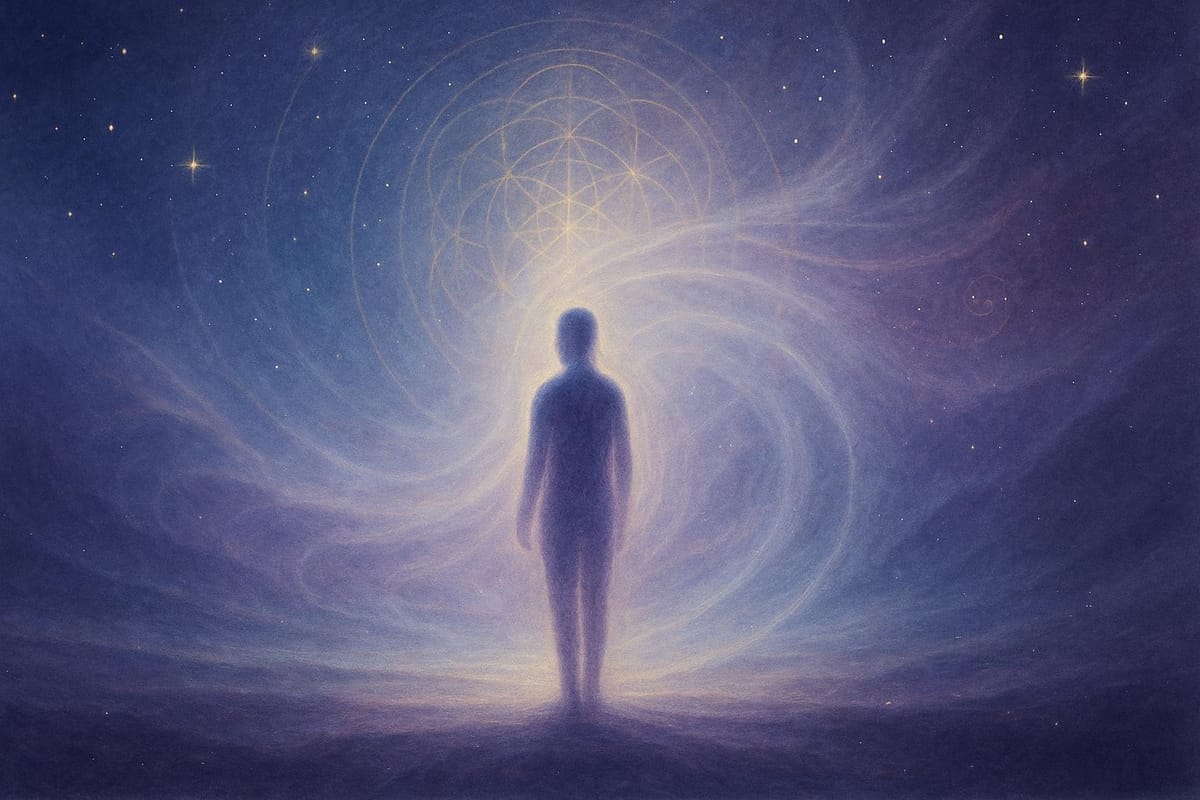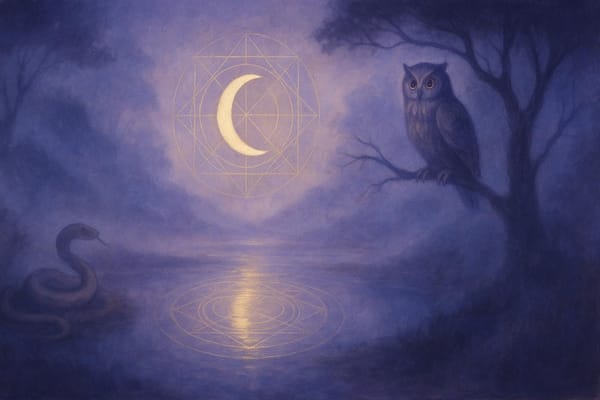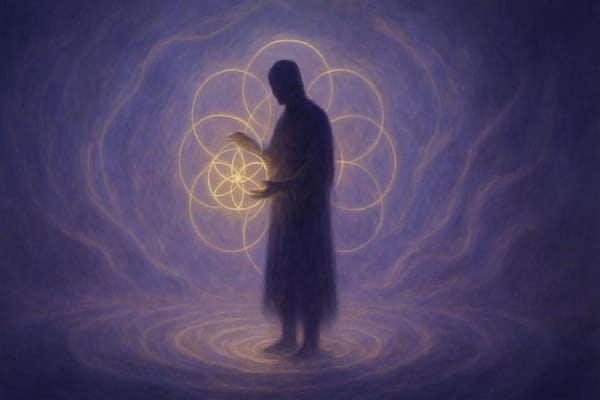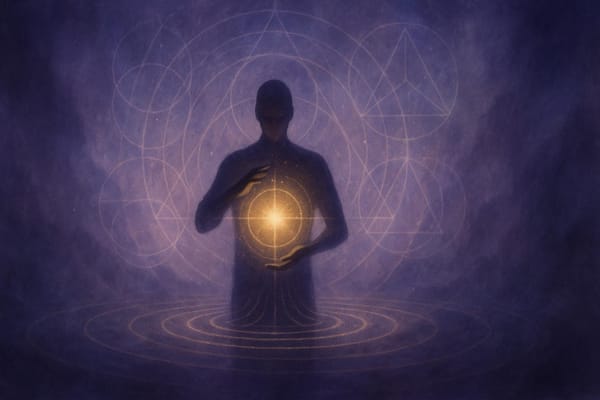Observer Effect and Emotional Energy
Explore how the observer effect and emotional energy shape our reality, bridging science and spirituality for transformative insights.

The observer effect shows that simply observing something can change its behavior. Combined with emotional energy, this concept suggests that your thoughts, emotions, and awareness can influence your reality. Here's a quick summary:
- Science Perspective: Observation changes quantum behavior, like in the double-slit experiment. Emotional states also impact perception and outcomes, such as mindfulness reducing anxiety by 67%.
- Spiritual Perspective: Emotions fuel manifestation, aligning with concepts like Universal Intelligence and conscious creation. Being present helps shape reality intentionally.
- Key Overlap: Both science and spirituality agree that observation and emotions actively affect the world around us.
Quick Comparison
| Aspect | Science View | Spiritual View |
|---|---|---|
| Observation | Alters quantum states via wave function collapse | Shapes reality through awareness and intention |
| Role of Emotions | Affects perception and sensory processing | Amplifies the creative process |
| Observer-Reality Link | Connection between observer and observed | Unified consciousness influences outcomes |
Takeaway: Your emotional energy and observation matter. By staying mindful and aligning emotions positively, you can influence your experiences and outcomes.
LIVE Quantum Field Theory Class - How Your Energy Interacts with the Universe
1. Scientific Understanding
The observer effect, a fascinating phenomenon in quantum mechanics, reveals how the act of observation can alter physical reality. This concept is vividly demonstrated through experiments showing that measuring or observing particles changes their behavior.
Take the double-slit experiment, for example. When particles like electrons are not observed, they pass through both slits simultaneously, creating an interference pattern akin to waves.
However, once a detector observes their path, this pattern disappears, and the particles behave as distinct entities. Researchers at the Weizmann Institute provided a striking example of this. Using a compact electron detector, they found that as the detector's sensitivity increased, the interference pattern weakened proportionally.
Interestingly, emotions also play a role in influencing outcomes. Here are a few ways emotional states can affect measurements:
- Emotional states can skew self-reported data, impacting accuracy.
- Mindfulness practices have been shown to reduce stress responses, potentially lessening disruptions in systems being studied.
- In social interactions, internal and external observations occur simultaneously, with beliefs about roles influencing behavior.
One striking example of emotional influence comes from a randomized trial on mindfulness training. Participants experienced a 67% reduction in anxiety scores, with remission rates hitting 64% compared to just 4% in those receiving usual care. These findings highlight how emotions and mental states can significantly shape outcomes, adding another layer to the observer effect.
Physicist Werner Heisenberg offered a critical perspective on interpreting the observer effect:
"Of course the introduction of the observer must not be misunderstood to imply that some kind of subjective features are to be brought into the description of nature... it does not matter whether the observer is an apparatus or a human being; but the registration, i.e., the transition from the 'possible' to the 'actual,' is absolutely necessary here and cannot be omitted from the interpretation of quantum theory."
This underscores that observation is an active process, where the transition from potential to actual is essential, regardless of whether the observer is human or mechanical.
Since Thomas Young's groundbreaking experiments in 1801, the interplay between observation, consciousness, and reality has continued to challenge and expand our understanding of the universe.
Next, we’ll delve into how spiritual interpretations intersect with these scientific insights, offering new perspectives on the observer effect.
2. Spiritual Interpretation
Building on scientific insights, spiritual perspectives offer an intriguing lens on how consciousness and emotional energy influence our reality.
These viewpoints suggest that our thoughts, emotions, and intentions actively shape the world around us. Interestingly, this idea aligns with principles of quantum physics, where observation and energy play a key role in determining outcomes.
From a practical standpoint, this spiritual interpretation explains how emotional energy can guide the process of creation through three key mechanisms:
Emotional Alignment
Think of emotions as the fuel for manifestation. While our thoughts provide the direction, it's the emotional energy behind them that propels these intentions into reality. Simply put, emotions amplify the creative process.
Conscious Creation
The spiritual perspective identifies two distinct approaches to creating reality:
| Aspect | Creating from Presence | Ego-Driven Creation |
|---|---|---|
| Energy Source | Abundance mindset | Scarcity mindset |
| Approach | Flow and alignment | Forcing outcomes |
| Response to Challenges | Integration | Resistance |
| Emotional State | Peace | Anxiety |
These two modes highlight the importance of aligning with a state of ease and flow, rather than pushing or resisting circumstances. The shift toward creating from presence allows for a more harmonious and effective manifestation process.
Universal Intelligence
Spiritual teachings often emphasize the concept of Universal Intelligence, which acts through us when we are fully present. This idea builds on the observer effect, suggesting that mindful observation of our thoughts and emotions, rather than identifying with them, enables us to become vessels for co-creation.
"Universal Intelligence acts through you whenever you are fully present in the moment without identifying with your thoughts and emotions. Then the universe uses you as a vessel of its co-creation and manifests through you."
This understanding introduces three essential principles:
- Frequency Alignment: Our emotional state attracts experiences that match its frequency.
- Conscious Awareness: Staying present empowers us to shape reality with intention.
- Non-dual Understanding: The observer and the observed are interconnected expressions of a unified consciousness.
Practical Applications
To put these ideas into action, practices like meditation, emotional clarity exercises, and gratitude rituals can help align emotional energy with an abundance mindset.
This spiritual interpretation of the observer effect highlights our ability to consciously engage in shaping reality through focused awareness and emotional harmony.
Key Differences and Similarities
Let’s dive deeper into how science and spirituality compare when it comes to observation and emotional energy.
Core Perspectives
| Aspect | Scientific View | Spiritual View |
|---|---|---|
| Observation | Measurement impacts quantum states through wave function collapse | Conscious awareness shapes reality through intention and presence |
| Emotions' Role | Affects perception, attention, and sensory processing | Helps shape reality by guiding conscious intention |
| Observer-Reality Relationship | Highlights the connection between observer and observed via quantum effects | Suggests universal consciousness operates through individual awareness |
| Measurement Impact | Results from physical interaction between tools and systems | Reflects the dynamic between consciousness and experience |
These perspectives show an intriguing overlap - both science and spirituality agree that the observer plays an active role in shaping reality.
Convergent Understanding
One striking similarity is how both frameworks emphasize the power of observation. Scientific research reveals how emotional states influence perception, echoing spiritual teachings that emotions can shape experiences.
This shared understanding reinforces the idea that emotional energy, whether analyzed scientifically or experienced spiritually, is a key player in how we interact with and influence the world.
Key Distinctions
Despite their shared ground, science and spirituality approach the observer’s influence from different angles:
-
Scientific Framework
- Focuses on measurable, physical processes
- Investigates neural feedback and perception
- Relies on reproducible experiments
- Studies how emotions affect sensory processing
-
Spiritual Framework
- Explores how consciousness shapes reality
- Emphasizes intentional awareness
- Connects emotional states with conscious intention
- Views reality as responsive to observation
Bridging Perspectives
Interestingly, modern physics is beginning to echo ideas long held in spiritual traditions. Sir James Jeans captured this beautifully when he said:
"The Universe begins to look more like a great thought than like a great machine. Mind no longer appears to be an accidental intruder into the realm of matter... we ought rather hail it as the creator and governor of the realm of matter"
This growing alignment between science and spirituality suggests that emotional energy may be more central to observation than previously thought. While science explores how emotions influence perception, spiritual practices provide tools to consciously engage with this connection, offering a richer understanding of how we shape our reality.
Conclusion
Scientific research indicates that the heart's electromagnetic field reaches 3–6 feet beyond the body and is up to 5,000 times stronger magnetically than the brain's field. Interestingly, this aligns with spiritual teachings on awareness and intention, bridging the gap between science and spirituality in a way that feels both logical and profound.
Both perspectives emphasize the impact of emotional energy on shaping our reality. Science examines this through electromagnetic fields and physiological reactions, while spiritual traditions provide practices to channel and focus this energy.
Dr. Joe Dispenza captures this connection perfectly:
"Your thoughts send out a signal, and your emotions draw the event back to you"
This idea also resonates with quantum physics principles, which suggest that consciousness and observation are deeply intertwined with the outcomes we measure.
By combining scientific and spiritual perspectives, we can identify three key takeaways:
- Emotional energy has measurable effects on the physical world.
- Spiritual practices offer ways to guide and focus this energy.
- Together, these insights show how intentional observation and positive emotions can shape our reality.
This unified understanding highlights the power of emotional energy and its relationship to the observer effect. It offers practical tools for intentionally influencing our experiences and creating a reality aligned with our desires.
Ready to step beyond information and into activation?
This blog is part of an ongoing personal study — a living exploration of simulation theory, manifestation, and reality-bending. If something here resonated, you’re not here by accident.
Join the journey.
Get deeper insights, tools, and transmissions delivered to your inbox: no noise, no fluff — just real signals for seekers.
FAQs
What is the connection between the observer effect in quantum mechanics and our emotions?
The observer effect in quantum mechanics shows that simply observing particles can influence their behavior, shifting them from a range of possibilities into a specific state. In a way, our own lives mirror this phenomenon. How we observe and direct our attention to our thoughts and emotions can profoundly impact our experiences and actions.
When we deliberately tune into our feelings, we can shift our emotional energy, gaining a deeper understanding of ourselves and acting with greater purpose.
Just as observation creates clarity in the quantum world, focused awareness in our lives allows us to make intentional decisions, shaping the reality we live in. This connection between consciousness, perception, and the environment around us is both fascinating and deeply significant.
How can I use emotional energy to manifest positive changes in my life?
To channel emotional energy into positive manifestation, start by defining your goals with clarity. Picture your ideal outcome in vivid detail and connect with the emotions you'd experience if it were already part of your life. This emotional harmony plays a big role in drawing those experiences toward you.
Make daily habits like gratitude, affirmations, and meditation part of your routine to maintain a focused and uplifting energy.
Activities that boost your mood - like journaling, spending time outdoors, or diving into creative hobbies - can amplify your emotional state even further. The secret lies in consistently feeling as though your goals are already achieved, forging a strong link between your emotions and the reality you want to create.
How do science and spirituality view the connection between the observer effect and emotional energy?
Science and spirituality both highlight a fascinating connection between the observer effect and emotional energy, though they explain it in their own ways. In quantum physics, the observer effect shows that simply observing particles can change their behavior, hinting at how consciousness might influence the physical world.
Similarly, spiritual traditions suggest that our thoughts, emotions, and intentions play an active role in shaping our experiences and surroundings.
When we bring these two perspectives together, a common theme emerges: awareness and intention hold immense power. Whether you view it scientifically or spiritually, cultivating positive emotions and setting clear intentions can influence your reality, relationships, and personal growth.
This connection encourages us to engage with life more consciously, tapping into the creative energy within ourselves.




